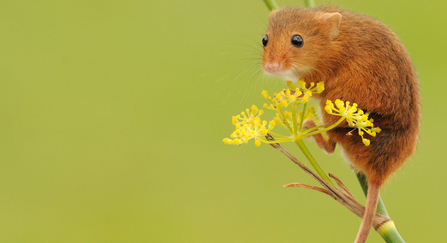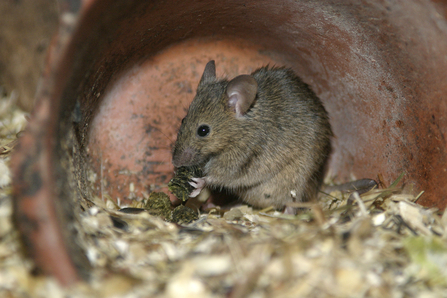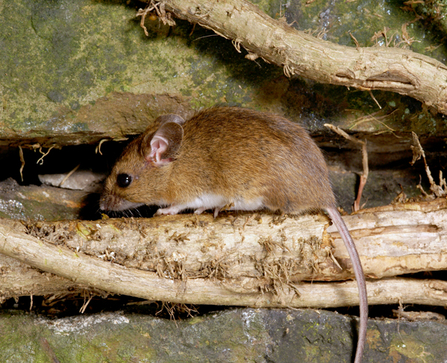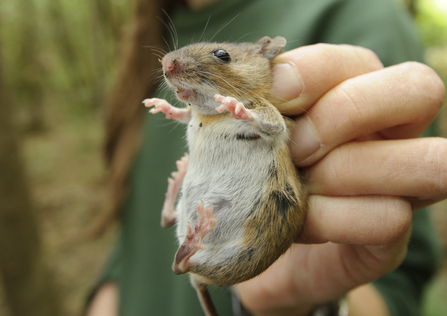
Amy Lewis
I’ll head straight to the smallest mouse and the UK’s smallest rodent. At around 10g, harvest mice are the weight of a 20p piece and so tiny that they are very rarely seen. With a body length of 7cm, chestnut fur, and a long, twisty tail that is used to grip plant stems to help them climb, they are easily distinguished from other mice – if you are lucky enough to see one!
They tend to be associated with cereal crop fields, but are found in a variety of places. They like rough grasslands and reedbeds; or anywhere with plants offering long, tall stems, which are perfect for constructing their nests. Up to the size of a tennis ball, these nests are intricately woven onto plant stalks and lined with finer grasses, or anything else with good insulator properties.
Their nests are a key sign that they are present in an area; it is much easier to spot something the size of a tennis ball than a creature smaller than your thumb! Nest hunts are the best way to learn more about harvest mouse distribution in the UK.
Like other mice, they are attracted to seeds and grains. As a result, they occasionally show up unexpectedly around bird feeders during the winter, when natural seed sources are low. They are much more active in spring and summer, when they breed and build nests – but the chances of spotting one is always low!
Voles are often mistaken for mice. Bank voles and common voles have smaller eyes (they are more active during the day), smaller ears, and often scurry around, unlike mice, which are much bouncier.
House mouse

©Wildstock
This mouse is synonymous with sharing buildings with humans. With lots of free food on offer and central heating, it is easy to see why!
House mice are usually around twice the weight of harvest mice and have a uniform grey/brown coat. They look similar to rats, but are much smaller and shyer, which is why many people with house mice raiding their pantries never actually spot the culprit. Although they can be found across most of the UK, they are less dominant than the next two mouse species. So in areas with high numbers of the next two species and low food supplies, house mice are often absent.
Baby mice are called pups, or pinkies, as they are born without fur.
Wood mouse

©Paul Adams
The name wood mouse is a misnomer as these adaptable mice will live anywhere! As long as they have safe cover and a good supply of food, they are quite happy. Like house mice, they will happily build nests in wall cavities, sheds, and garages. But in a natural environment, they favour making nests in the bases of trees and shrubs. Around the same size as a house mouse, wood mice are more chestnut-brown and have very large eyes and prominent ears. They are found throughout the UK and are the mouse you’re most likely to spot.
Wood mice and yellow-necked mice can jump up to 30 times their own body height!
Yellow-necked mouse

Yellow-necked mouse being held during a survey of nest boxes © Terry Whittaker/2020VISION
I’ve left the largest and feistiest UK mouse until last! I’ve had years of experience of trapping them as part of small mammal surveys. In my experience, it is safe to say that yellow-necked mice are the feistiest of our native mice. With teeth perfect for nibbling through hard nut shells and into fruit stones, they make light work of a human finger!
They are similar in appearance to wood mice, but they have a stand-out yellow/brown band across the front of their throat. They are also usually 1.5 times bigger than wood mice. Yellow-necks are associated with the native woodlands of Wales and the Marches, but have been found further east into the Midlands on small mammal surveys and sometimes living in people’s garages. Along with wood mice, they are attracted to peanuts and bird seeds, so can be easily lured in front of a camera trap to help monitor them. They are very territorial, particularly when food supplies are limited and are dominant over wood and house mice.
Mice are great climbers and have adapted their natural tree and plant-climbing ability to climbing manmade structures.
